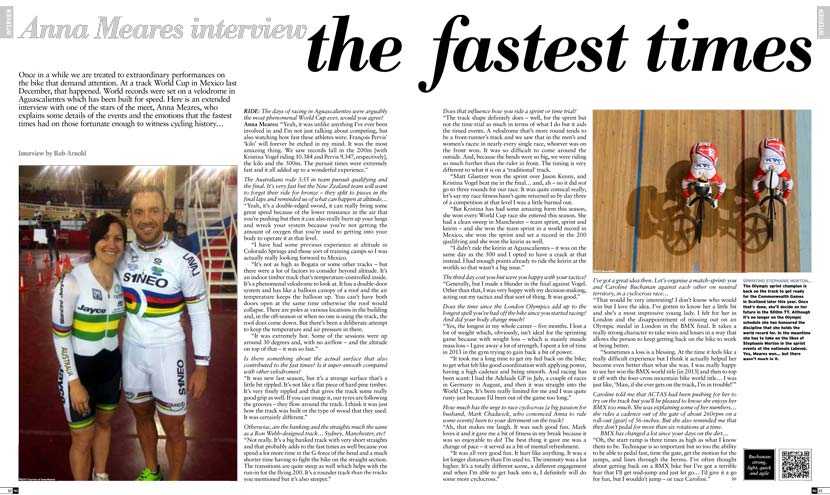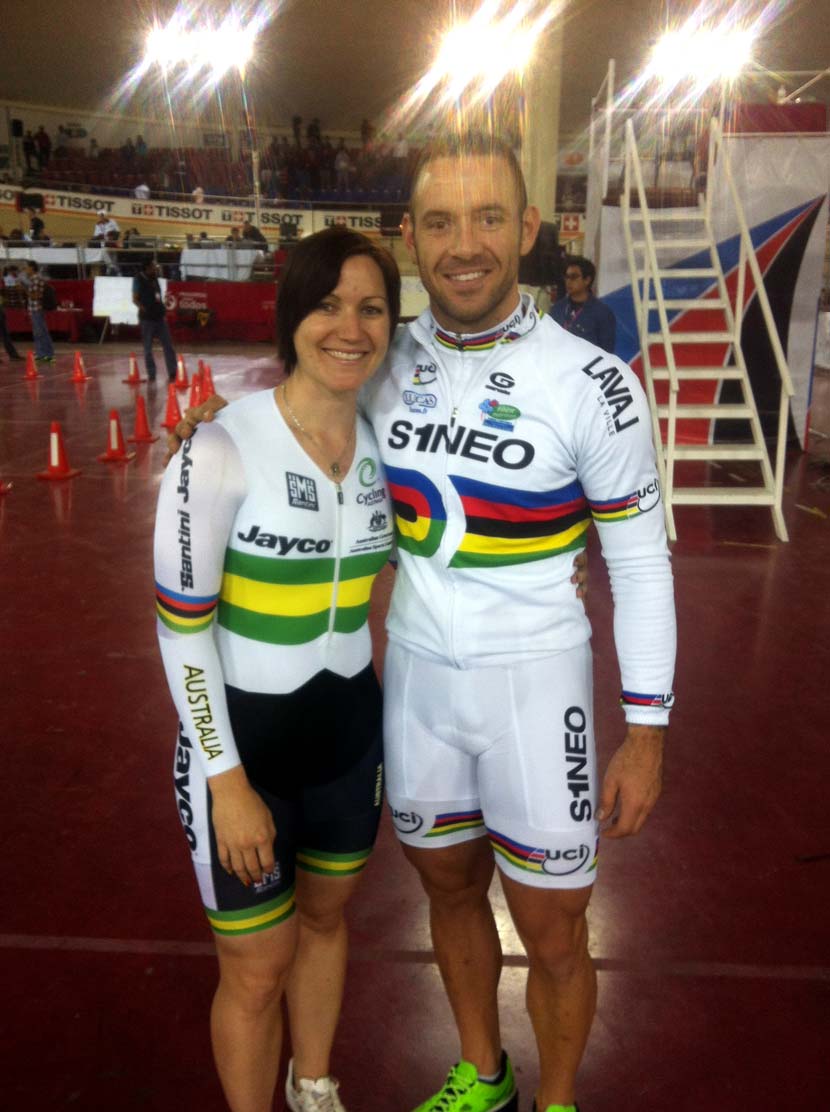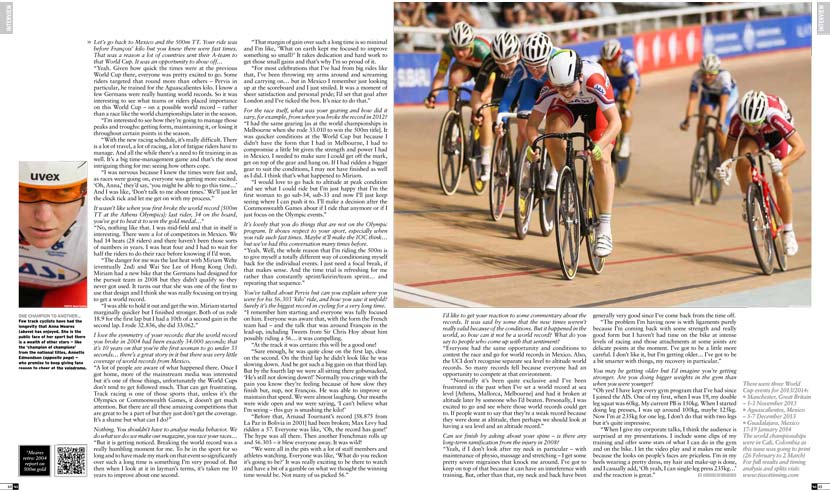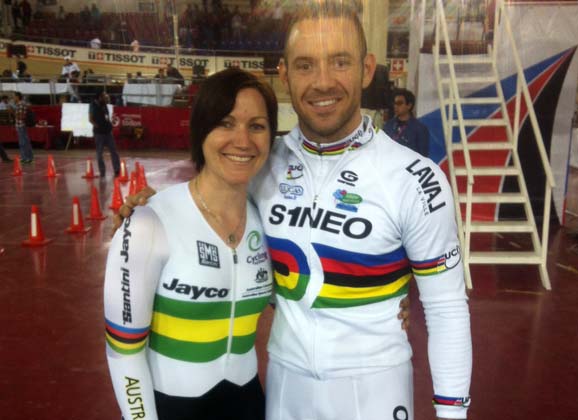In November 2013, the UCI held a round of the track cycling World Cup in Aguascalientes in Mexico. It proved to be one of the fastest meets in the history of cycling. World records in the 500m TT and ‘kilo’ were set by Anna Meares and François Pervis, respectively: 32.836 sec and 56.303 sec. The sprint times were phenomenally fast and some endurance athletes also benefitted from the conditions in what is arguably the quickest track in the world. It is to be the site of Thomas Dekker’s hour record attempt today (25 February 2015)… and with this in mind, we thought it an appropriate time to publish an online version of the interview with Meares. She explains the nature of the track and offers her thoughts on why it’s so conducive to fast times…
(This feature was originally published in RIDE #63, in March 2014.)

Anna Meares interview: the fastest times
Once in a while we are treated to extraordinary performances on the bike that demand attention. At a track World Cup in Mexico last December, that happened. World records were set on a velodrome in Aguascalientes which has been built for speed. Here is an extended interview with one of the stars of the meet, Anna Meares, who explains some details of the events and the emotions that the fastest times had on those fortunate enough to witness cycling history…
– Interview by Rob Arnold
RIDE: The days of racing in Aguascalientes were arguably the most phenomenal World Cup ever, would you agree?
Anna Meares: “Yeah, it was unlike anything I’ve ever been involved in and I’m not just talking about competing, but also watching how fast these athletes were. François Pervis’ ‘kilo’ will forever be etched in my mind. It was the most amazing thing. We saw records fall in the 200m [with Kristina Vogel riding 10.384 and Pervis 9.347, respectively], the kilo and the 500m. The pursuit times were extremely fast and it all added up to a wonderful experience.”
The Australians rode 3:55 in team pursuit qualifying and the final. It’s very fast but the New Zealand team will want to forget their ride for bronze – they split to pieces in the final laps and reminded us of what can happen at altitude…
“Yeah, it’s a double-edged sword, it can really bring some great speed because of the lower resistance in the air that you’re pushing but then it can also really burn up your lungs and wreck your system because you’re not getting the amount of oxygen that you’re used to getting into your body to operate it at that level.
“I have had some previous experience at altitude in Colorado Springs and those sort of training camps so I was actually really looking forward to Mexico.
“It’s not as high as Bogata or some other tracks – but there were a lot of factors to consider beyond altitude. It’s an indoor timber track that’s temperature-controlled inside. It’s a phenomenal velodrome to look at. It has a double-door system and has like a balloon canopy of a roof and the air temperature keeps the balloon up. You can’t have both doors open at the same time otherwise the roof would collapse. There are poles at various locations in the building and, in the off-season or when no one is using the track, the roof does come down. But there’s been a deliberate attempt to keep the temperature and air pressure in there.
“It was extremely hot. Some of the sessions were up around 30 degrees and, with no airflow – and the altitude on top of that – it was so fast.”
Is there something about the actual surface that also contributed to the fast times? Is it super-smooth compared with other velodromes?
“It was new last season, but it’s a strange surface that’s a little bit rippled. It’s not like a flat piece of hard pine timber. It’s very finely rippled and that gives the track some really good grip as well. If you can image it, our tyres are following the grooves – they flow around the track. I think it was just how the track was built or the type of wood that they used. It was certainly different.”
Otherwise, are the banking and the straights much the same as a Ron Webb-designed track… Sydney, Manchester, etc?
“Not really. It’s a big banked track with very short straights and that probably adds to the fast times as well because you spend a lot more time in the G-force of the bend and a much shorter time having to fight the bike on the straight section. The transitions are quite steep as well which helps with the run-in for the flying 200. It’s a rounder track than the tracks you mentioned but it’s also steeper.”
Does that influence how you ride a sprint or time trial?
“The track shape definitely does – well, for the sprint but not the time trial as much in terms of what I do but it aids the timed events. A velodrome that’s more round tends to be a front-runner’s track and we saw that in the men’s and women’s races: in nearly every single race, whoever was on the front won. It was so difficult to come around the outside. And, because the bends were so big, we were riding so much further than the rider in front. The timing is very different to what it is on a ‘traditional’ track.
“Matt Glaetzer won the sprint over Jason Kenny, and Kristina Vogel beat me in the final… and, ah – no it did not go to three rounds for our race. It was quite comical really; let’s say my race fitness hasn’t quite returned so by day three of a competition at that level I was a little burned out.
“But Kristina has had some amazing form this season, she won every World Cup race she entered this season. She had a clean sweep in Manchester – team sprint, sprint and keirin – and she won the team sprint in a world record in Mexico, she won the sprint and set a record in the 200 qualifying and she won the keirin as well.
“I didn’t ride the keirin at Aguascalientes – it was on the same day as the 500 and I opted to have a crack at that instead. I had enough points already to ride the keirin at the worlds so that wasn’t a big issue.”
The third day cost you but were you happy with your tactics?
“Generally, but I made a blunder in the final against Vogel. Other than that, I was very happy with my decision-making, acting out my tactics and that sort of thing. It was good.”

Record breakers: Meares and Pervis… masters of the TT – 500m and ‘kilo’ world record holders, respectively.
Does the time since the London Olympics add up to the longest spell you’ve had off the bike since you started racing? And did your body change much?
“Yes, the longest in my whole career – five months. I lost a lot of weight which, obviously, isn’t ideal for the sprinting game because with weight loss – which is mainly muscle mass loss – I gave away a lot of strength. I spent a lot of time in 2013 in the gym trying to gain back a bit of power.
“It took me a long time to get my feel back on the bike; to get what felt like good coordination with applying power, having a high cadence and being smooth. And racing has been scant: I had the Adelaide GP in July, a couple of races in Germany in August, and then it was straight into the World Cups. It’s been really limited for me and I was quite rusty just because I’d been out of the game too long.”
How much has the urge to race cyclocross [a big passion for husband, Mark Chadwick, who convinced Anna to ride some events] been to your detriment on the track?
“Ah, that makes me laugh. It was such good fun. Mark loves it and it gave me a bit of fitness in my break because it was so enjoyable to do! The best thing it gave me was a change of pace – it served as a bit of mental refreshment.
“It was all very good fun. It hurt like anything. It was a lot longer distances than I’m used to. The intensity was a lot higher. It’s a totally different scene, a different engagement and when I’m able to get back into it, I definitely will do some more cyclocross.”
I’ve got a great idea then. Let’s organise a match-sprint: you and Caroline Buchanan against each other on neutral territory, in a cyclocross race…
“That would be very interesting! I don’t know who would win but I love the idea. I’ve gotten to know her a little bit and she’s a most impressive young lady. I felt for her in London and the disappointment of missing out on an Olympic medal in London in the BMX final. It takes a really strong character to take wins and losses in a way that allows the person to keep getting back on the bike to work at being better.
“Sometimes a loss is a blessing. At the time it feels like a really difficult experience but I think it actually helped her become even better than what she was. I was really happy to see her win the BMX world title [in 2013] and then to top it off with the four-cross mountain bike world title… I was just like, ‘Man, if she ever gets on the track, I’m in trouble!’”
Caroline told me that ACTAS had been pushing for her to try on the track but you’ll be pleased to know she enjoys her BMX too much. She was explaining some of her numbers… she rides a cadence out of the gate of about 260rpm on a roll-out [gear] of 56-inches. But she also reminded me that they don’t pedal for more than six rotations at a time.
BMX has changed a lot since your days on the dirt…
“Oh, the start ramp is three times as high as what I know them to be. Technique is so important but so too the ability to be able to pedal fast, time the gate, get the motion for the jumps, and lines through the berms. I’ve often thought about getting back on a BMX bike but I’ve got a terrible fear that I’ll get mid-jump and just let go… I’d give it a go for fun, but I wouldn’t jump – or race Caroline.”

Let’s go back to Mexico and the 500m TT. Your ride was before François’ kilo but you knew there were fast times. That was a reason a lot of countries sent their A-team to that World Cup. It was an opportunity to show off…
“Yeah. Given how quick the times were at the previous World Cup there, everyone was pretty excited to go. Some riders targeted that round more than others – Pervis in particular, he trained for the Aguascalientes kilo. I know a few Germans were really hunting world records. So it was interesting to see what teams or riders placed importance on this World Cup – on a possible world record – rather than a race like the world championships later in the season.
“I’m interested to see how they’re going to manage those peaks and troughs: getting form, maintaining it, or losing it throughout certain points in the season.
“With the new racing schedule, it’s really difficult. There is a lot of travel, a lot of racing, a lot of fatigue riders have to manage. And all the while there’s a need to fit training in as well. It’s a big time-management game and that’s the most intriguing thing for me: seeing how others cope.
“I was nervous because I knew the times were fast and, as races were going on, everyone was getting more excited. ‘Oh, Anna,’ they’d say, ‘you might be able to go this time…’ And I was like, ‘Don’t talk to me about times.’ We’ll just let the clock tick and let me get on with my process.”
It wasn’t like when you first broke the world record [500m TT at the Athens Olympics]: last rider, 34 on the board, you’ve got to beat it to win the gold medal…*
“No, nothing like that. I was mid-field and that in itself is interesting. There were a lot of competitors in Mexico. We had 14 heats (28 riders) and there haven’t been those sorts of numbers in years. I was heat four and I had to wait for half the riders to do their race before knowing if I’d won.
“The danger for me was the last heat with Miriam Welte (eventually 2nd) and Wai Sze Lee of Hong Kong (3rd). Miriam had a new bike that the Germans had designed for the pursuit team in 2008 but they didn’t qualify so they never got used. It turns out that she was one of the first to use that design and I think she was really focusing on trying to get a world record.
“I was able to hold it out and get the win. Miriam started marginally quicker but I finished stronger. Both of us rode 18.9 for the first lap but I had a 10th of a second gain in the second lap. I rode 32.836, she did 33.062.”
I love the symmetry of your records: that the world record you broke in 2004 had been exactly 34.000 seconds; that it’s 10 years on that you’re the first woman to go under 33 seconds… there’s a great story in it but there was very little coverage of world records from Mexico.
“A lot of people are aware of what happened there. Once I got home, more of the mainstream media was interested but it’s one of those things, unfortunately the World Cups don’t tend to get followed much. That can get frustrating. Track racing is one of those sports that, unless it’s the Olympics or Commonwealth Games, it doesn’t get much attention. But there are all these amazing competitions that are great to be a part of but they just don’t get the coverage. It’s a shame but what can I do?”
Nothing. You shouldn’t have to analyse media behavior. We do what we do: we make our magazine, you race your races…
“But it is getting noticed. Breaking the world record was a really humbling moment for me. To be in the sport for so long and to have made my mark on that event so significantly over such a long time is something I’m very proud of. But then when I look at it in layman’s terms, it’s taken me 10 years to improve about one second.
“That margin of gain over such a long time is so minimal and I’m like, ‘What on earth kept me focused to improve something so small?’ It takes dedication and hard work to get those small gains and that’s why I’m so proud of it.
“For most celebrations that I’ve had from big rides like that, I’ve been throwing my arms around and screaming and carrying on… but in Mexico I remember just looking up at the scoreboard and I just smiled. It was a moment of sheer satisfaction and personal pride; I’d set that goal after London and I’ve ticked the box. It’s nice to do that.”
For the race itself, what was your gearing and how did it vary, for example, from when you broke the record in 2012?
“I had the same gearing [as at the world championships in Melbourne when she rode 33.010 to win the 500m title]. It was quicker conditions at the World Cup but because I didn’t have the form that I had in Melbourne, I had to compromise a little bit given the strength and power I had in Mexico. I needed to make sure I could get off the mark, get on top of the gear and hang on. If I had ridden a bigger gear to suit the conditions, I may not have finished as well as I did. I think that’s what happened to Miriam.
“I would love to go back to altitude at peak condition and see what I could ride but I’m just happy that I’m the first woman to go sub-34, sub-33 and now I’ll just keep seeing where I can push it to. I’ll make a decision after the Commonwealth Games about if I ride that anymore or if I just focus on the Olympic events.”
It’s lovely that you do things that are not on the Olympic program. It shows respect to your sport, especially when you ride such fast times. Maybe it’ll make the IOC think… but we’ve had this conversation many times before.
“Yeah. Well, the whole reason that I’m riding the 500m is to give myself a totally different way of conditioning myself back for the individual events. I just need a focal break, if that makes sense. And the time trial is refreshing for me rather than constantly sprint/keirin/team sprint… and repeating that sequence.”
You’ve talked about Pervis but can you explain where you were for his 56.303 ‘kilo’ ride, and how you saw it unfold? Surely it’s the biggest record in cycling for a very long time.
“I remember him starting and everyone was fully focused on him. Everyone was aware that, with the form the French team had – and the talk that was around François in the lead-up, including Tweets from Sir Chris Hoy about him possibly riding a 56… it was compelling.
“At the track it was certain: this will be a good one!
“Sure enough, he was quite close on the first lap, close on the second. On the third lap he didn’t look like he was slowing down. And he got such a big gain on that third lap. But by the fourth lap we were all sitting there gobsmacked, ‘He’s still not slowing down!’ Normally you cringe with the pain you know they’re feeling because of how slow they finish but, nup, not François. He was able to improve or maintain that speed. We were almost laughing. Our mouths were wide open and we were saying, ‘I can’t believe what I’m seeing – this guy is smashing the kilo!’
“Before that, Arnaud Tournant’s record [58.875 from La Paz in Bolivia in 2001] had been broken; Max Levy had ridden a 57. Everyone was like, ‘Oh, the record has gone!’ The hype was all there. Then another Frenchman rolls up and 56.303 – it blew everyone away. It was wild!
“We were all in the pits with a lot of staff members and athletes watching. Everyone was like, ‘What do you reckon it’s going to be?’ It was really exciting to be there to watch and have a bit of a gamble on what we thought the winning time would be. Not many of us picked 56.”
I’d like to get your reaction to some commentary about the records. It was said by some that the new times weren’t really valid because of the conditions. But it happened in the world, so how can it not be a world record? What do you say to people who come up with that sentiment?
“Everyone had the same opportunity and conditions to contest the race and go for world records in Mexico. Also, the UCI don’t recognise separate sea level to altitude world records. So many records fell because everyone had an opportunity to compete at that environment.
“Normally it’s been quite exclusive and I’ve been frustrated in the past when I’ve set a world record at sea level [Athens, Mallorca, Melbourne] and had it broken at altitude later by someone who I’d beaten. Personally, I was excited to go and see where those world records could get to. If people want to say that they’re a weak record because they were done at altitude, then perhaps we should look at having a sea level and an altitude record.”
Can we finish by asking about your spine – is there any long-term ramification from the injury in 2008?
“Yeah, if I don’t look after my neck in particular – with maintenance of physio, massage and stretching – I get some pretty severe migraines that knock me around. I’ve got to keep on top of that because it can have an interference with training. But, other than that, my neck and back have been generally very good since I’ve come back from the time off.
“The problem I’m having now is with ligaments purely because I’m coming back with some strength and really good form but I haven’t had time on the bike at intense levels of racing and those attachments at some joints are delicate points at the moment. I’ve got to be a little more careful. I don’t like it, but I’m getting older… I’ve got to be a bit smarter with things, my recovery in particular.”
You may be getting older but I’d imagine you’re getting stronger. Are you doing bigger weights in the gym than when you were younger?
“Oh yes! I have kept every gym program that I’ve had since I joined the AIS. One of my first, when I was 19, my double leg squat was 60kg. My current PB is 150kg. When I started doing leg presses, I was up around 100kg, maybe 125kg. Now I’m at 235kg for one leg. I don’t do that with two legs but it’s quite impressive.
“When I give my corporate talks, I think the audience is surprised at my presentations. I include some clips of my training and offer some stats of what I can do in the gym and on the bike. I let the video play and it makes me smile because the looks on people’s faces are priceless. I’m in my heels wearing a pretty dress, my hair and make-up is done, and I casually add, ‘Oh yeah, I can single-leg press 235kg…’ and the reaction is great.”
– Interview by Rob Arnold



